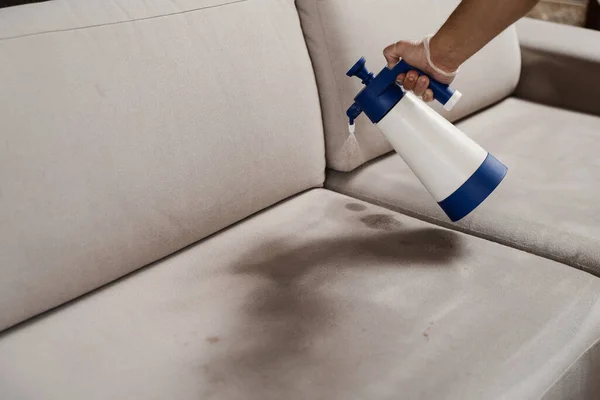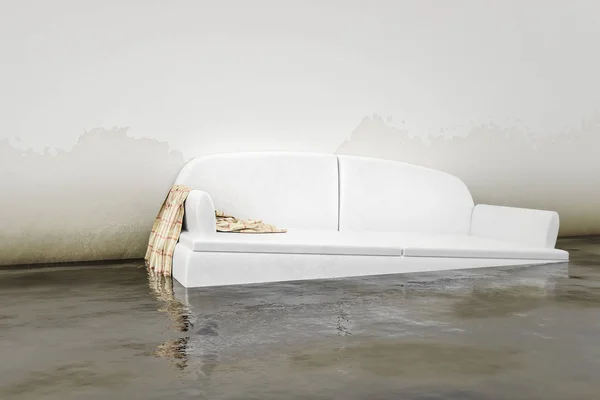Cleaning mold off your couch is essential to maintain a clean and healthy environment. Mold growth on furniture can not only be unsightly but can also pose health risks. This blog will provide you with instructions on how to identify mold on your couch and go through the cleaning process.
Identifying Mold on Your Couch
Visual Inspection: Start by visually examining your couch for any visible signs of mold. These signs may include black, brown, green, or white patches on the fabric’s surface, which can also have a fuzzy or slimy texture.
Musty Odor Check: Another way to identify mold is by checking for a distinct musty smell. If you happen to notice an unpleasant odor emanating from your couch, it could be an indication of mold growth.
Discoloration Observation: Mold often causes discoloration on the fabric. Therefore, keep an eye out for any noticeable changes in color, such as dark spots or stains.
Why is It Important to Clean Mold Off Your Couch?
Mold can pose serious health risks. Exposure to mold can lead to respiratory problems, allergies, and skin irritations. In individuals with weakened immune systems, breathing in mold spores can even result in coughing, wheezing, and infections.
Additionally, mold growth can not only damage your couch but also spread to other furniture and belongings in your home. This can weaken the structural integrity of your couch, causing it to sag or even collapse. Moreover, mold growth on your couch is unsightly and can create unpleasant odors in your living space.
How to Clean Mold Off Your Couch
In this section, we’ll walk you through the process step-by-step, from gathering the necessary supplies to preparing your couch for cleaning.
Preparation Steps Before Cleaning
Inspect the area: Thoroughly examine the moldy areas on your couch to assess the extent of the mold growth and identify any underlying causes, such as leaks or moisture issues.
Wear protective gear: Prioritize your safety by putting on necessary protective gear, including gloves, a mask, and goggles. This protective gear will shield you from inhaling mold spores or coming into direct contact with them.

Ventilate the area: Enhance airflow and ventilation during the cleaning process by opening windows and doors. This will effectively prevent the spread of mold spores to other parts of your home.
Remove any loose debris: Utilize a vacuum cleaner with a HEPA filter to effectively eliminate any loose mold spores or debris from the affected areas of the couch. Ensure you empty the vacuum cleaner outside of your home to prevent the spores from re-entering your living space.
Create a cleaning solution: Mix warm water with a mild detergent or vinegar to create a solution that will effectively kill the mold and eliminate any stains or odors. Avoid using bleach as it may harm the fabric of your couch.
Test on a small, inconspicuous area: Before applying the cleaning solution to the moldy areas of your couch, perform a test on a small, hidden area to ensure that it does not cause any discoloration or damage to the fabric.
Cleaning Process
- Vacuum the affected area using a vacuum cleaner with a HEPA filter to trap any loose mold spores and prevent them from spreading.
- Spray the cleaning solution generously on the moldy areas of the couch, ensuring thorough coverage.
- Use a soft brush or sponge to scrub the mold gently in a circular motion. This will help remove the mold and prevent it from reappearing.
- Wipe down the moldy areas with a clean cloth or sponge dipped in clean water to remove any residue.
- Allow the couch to air dry completely. You can place a fan or open windows to enhance airflow and speed up the drying process.
- Dispose of the protective gear and clean the vacuum filter to prevent any potential cross-contamination.
Tips for Preventing Mold Growth
- Keep the area around your couch clean and dry. Mold thrives in damp and humid environments, so it’s crucial to promptly clean up any spills or moisture that may occur.
- Ensure proper ventilation in your home. Good airflow plays a vital role in preventing excess moisture buildup, which can ultimately lead to mold growth.
- Avoid placing your couch against walls or furniture that obstruct airflow. Make sure to leave some space around your couch to allow for proper air circulation.
- Consider using a dehumidifier in areas that tend to have high humidity. This will help reduce the moisture in the air and prevent the development of mold.
- Regularly clean and vacuum your couch to eliminate any dust or dirt that can contribute to mold growth. Pay particular attention to the crevices and corners where mold can easily hide.
- Avoid placing wet items or damp clothing on your couch. Moisture can seep into the fabric and create a favorable breeding ground for mold.
- If you notice any signs of mold on your couch, such as a musty odor or visible mold growth, take immediate action to clean it off and address the underlying cause of moisture.
- Regularly inspect your couch for any signs of water damage or leaks. If you identify any issues, address them promptly to prevent mold growth.
- If your home has experienced water damage or flooding, it is essential to thoroughly dry and clean your couch to prevent the spread of mold.
When to Seek Professional Help
If you observe a persistent and unpleasant smell coming from your couch, particularly accompanied by other signs of mold like discoloration or visible growth, it indicates that you should contact a professional.

If there are patches of visible mold growth on your couch, whether on the surface or in the crevices, it is a clear indication that you require professional help. Trying to clean the mold on your own might not effectively eliminate all the spores, and the issue can quickly spread.
If you have previously cleaned the mold off your couch but it keeps reappearing, it indicates that there may be an underlying issue causing moisture accumulation. If you are in Minneapolis, Minnesota and need help in professional cleaning whether residential or commercial, Ivy Cleans is here to help. Contact us today and our representative will assist you.
If you’re looking for more content like this read our blog on how to clean mold from pebble shower floor.
